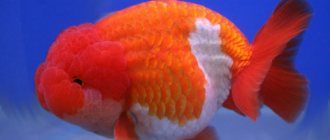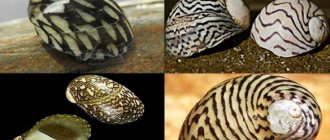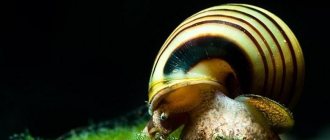Freshwater snails are a decorative element in the design of an aquarium, which has a useful function. Mollusks are good orderlies.
They feed on uneaten fish food, bacterial plaque, and dead plants. And by some species you can determine the state of the water.
Maryse is a reel snail, popular due to its beautiful appearance and large size, and is a close relative of Ampularia.
Habitat: stagnant or slow-flowing fresh water bodies (lakes, ponds, swamps, rivers), prefer shallow water surfaces and dense vegetation.
Table of basic parameters of maintenance, care and nutrition:
| What should be the volume of the aquarium? | 1 individual 10 liters |
| What should be the temperature in the aquarium? | from +21-25° C |
| What should the pH be? | from 7-8 pH |
| What should the water hardness be? | from 8-15° dH |
| What should be the substrate for an aquarium? | coarse sand or soil with a granule size of 3-4 mm |
| What kind of lighting should there be? | moderate |
| What should be the movement of water | moderate |
| Maximum snail size | width 2 cm, height 6 cm |
| What does it eat? | aquarium algae: healthy or rotting; special food for snails; fish food; raw or boiled vegetables; fruits |
| Type of aquarium snail | peaceful |
| Who is compatible with in an aquarium? | compatible with all peaceful aquarium inhabitants |
| Lifespan | from 2-4 years depending on the type and conditions |
Appearance of the Maryse snail
Marisa cornuarietis is a large mollusk with a picturesque appearance. The shell is flattened, consists of 3-4 turns, twisted clockwise. Width 2 cm, height 6 cm. The mouth is covered by a small cap. The color varies from yellow to brown (depending on the habitat and food consumed), there are longitudinal stripes. The body is white or beige with yellow, gray and black patterns.
The respiratory system occurs through the gills and lungs. Pulmonary respiration is carried out using a short tube that is removed as Maryse rises to the surface.
The mouth is in the form of a proboscis, the organs of vision are on the head tentacles, which distinguish only between light and dark areas. Hearing is also poorly developed, but the sense of smell is acute. Mollusks communicate with each other through touch.
Thanks to her muscular leg, Maryse is able to move quickly. The mucus it secretes has healing properties.
Interesting Facts
- It is believed that large snails get used to their owner and begin to recognize him.
- Maryses move slowly and smoothly around the aquarium, and watching them is a great pleasure, which is truly mesmerizing and calming, no worse than a relaxation session with a psychologist.
- Doctors have not noted a single case of allergy to snails. And it is believed that the mucus of mollusks is medicinal: cuts and small wounds on the hands heal much faster if you let the snails crawl a little over the damaged surface.
Those who are hesitant to have pets because they are afraid of dirt, smell or noise should know that marise clams do not smell, do not make noise, do not chew house shoes and furniture, do not scratch floors, and do not need to be walked with them in the mornings or evenings. Many shellfish lovers joke that aquarium inhabitants are animals for the lazy.
Even if at first the idea of having snails or mollusks seems funny to you, think that maybe these little creatures will teach you something new about the world around you!
Message Maryse snail contents breeding compatibility photo description. appeared first on AQUARIUM FISH.
Maintenance and care
It is not difficult to create comfortable conditions for the Maryse snail in an aquarium, because this mollusk is unpretentious. However, some rules still need to be followed:
- aquarium for 1 individual 10 liters. Do not leave the lid completely open, as Marisa can easily leave the artificial pond. It is recommended to leave a small space, because the snail needs access to air for pulmonary respiration. You should not decorate with live plants - they will only serve as another source of food;
- good filtration and aeration are required, but the flow in the aquarium should be weak;
- temperature from +21-25° C, acidity from 7-8 pH, hardness from 8-15° dH, presence of carbonates.
You should know that too acidic or soft water has a destructive effect on the sink. Insufficient mineralization causes metabolic problems.
The permissible minimum temperature limit is +18° C. At lower levels, Maryse falls into a coma: she does not move and does not appear from the shell. An increase in temperature causes accelerated metabolism, activity, mollusks reproduce faster, however, life expectancy is reduced from 4 years to 2 years.
Although Marisa is a freshwater snail, it can survive in water with a salinity of up to 30%, but will not reproduce in salted water.
Interesting to know
- Some argue that adults can get used to and recognize their owner.
- Due to their slow movement, watching snails is a very exciting and calming experience.
- There is no allergic reaction in people to snails. It is also believed that the mucus that occurs after the snail moves has a very good effect on human skin.
- When getting such pets, you should also take into account the fact that snails are absolutely silent and do not have an unpleasant odor, which is also their positive side.
Therefore, a fairly large number of breeders prefer Maryse snails as pets.
5 / 5 ( 1 voice )
What to feed
Maryse is an omnivorous snail that is distinguished by its gluttony. You can feed snails:
- aquarium plants and their remains;
- remains of other animals;
- plaque on the walls;
- fish caviar;
- dry food;
- tablets for catfish;
- vegetables (zucchini, carrots);
- egg white;
- lettuce leaves and apple are a favorite treat.
Overfeeding leads to contamination of the aquarium, as the snails begin to excrete a large amount of waste products. In a community aquarium, for the same reason, you need to monitor the nutrition of other inhabitants.
It is not recommended to keep living vegetation with marises. Mollusks with a boundless appetite will not rest until all representatives of the underwater flora are eaten; they will not disdain even the tough Anubias and Vallisneria. Some aquarists use this characteristic feature when fighting emerging harmful plants.
Feeding
Under no circumstances should mariza be left hungry. Her diet is quite wide:
- leftover fish food;
- fish droppings;
- protozoan algae;
- bacteria;
- dead sea animals;
- caviar of other shellfish.
They enjoy eating standard sea food and tableted seaweed. If the snails get hungry and don’t find anything edible, they will consider all aquarium plants as food. Moreover, they will eat them up at the roots, so that there will be nothing left.
In general, marises are quite voracious creatures and eat everything they find, even pieces of toilet paper.
Therefore, to avoid eating expensive aquarium plants, you should constantly put edible mixtures in the form of flakes on the bottom.
How to distinguish a male from a female. Reproduction and breeding in an aquarium
Maryses are not hermaphrodites. Females have a dark gray or chocolate body color. Males are distinguished by a lighter shade: beige with brown splashes.
To stimulate reproduction, the water temperature should not be lower than +25-27° C. Mating games last several hours, after which the female lays eggs in a cocoon on plants or decor. The eggs are 2-3 mm in size and are light spots surrounded by a transparent gelatinous shell. One clutch contains from 30 to 80 eggs, the incubation period lasts 8-24 days. The caviar increases to 4 mm, and small snails can already be seen.
After the babies hatch, they stay together for several days, feeding on the remains of the egg shell from which they hatched. They then disperse in search of new food. Not everyone survives. The reason for this is a lack of food; some individuals are eaten by other inhabitants of the aquarium or are sucked into the filter.
How to breed?
Unlike many of their relatives, marises are heterosexual snails. In addition, females and males are quite easy to distinguish from each other. Thus, males have a pale beige body with brown spots, while their lovers have a chocolate or dark brown body. Mating can last for several hours. After this, the lady lays eggs on plant leaves or hard surfaces. Externally, the eggs look like a jelly capsule with an egg enclosed inside. After 14–20 days, the eggs will hatch and the young will spread throughout the artificial reservoir.
The survival rate of snails is low. They often die as prey for fish, in a filter, or in the absence of food. To preserve as many individuals as possible, precautions must be taken already at the spawning stage. It is recommended to carefully transfer the eggs to a separate container and wait until the hatched marises grow up. If the amount of caviar is too large, the excess can be removed manually.
You will learn more about the mariz snail by watching the following video.
The Maryse snail is one of the most beautiful snails living in home aquariums, which does not require special feeding and maintenance conditions. In its natural environment, it is typical to occupy warm streams with fresh water, which are located in South America in the countries of Brazil, Honduras, Costa Rica and Venezuela. Due to the snail's ability to clear vegetation, it has been used as a cleaner in ponds and aquariums that are affected by excessive vegetation.
Thanks to its unusual appearance, the snail has become quite popular as a home aquarium inhabitant. Aquarium marise snails do not require difficult living conditions, however, some factors of their living are still worth taking into account.
Compatibility in the aquarium with other snails, shrimp and fish
Mariza is a calm resident who will not become a threat to neighbors in a common aquarium. The exception is fish caviar. The mollusk eats it with pleasure. And Goldfish are ideal neighbors because their maintenance does not require the presence of living vegetation in the aquarium. Also, multi-colored fish such as Guppies, Neons, Tetras, Ancistrus, Corydoras get along well with marises.
The danger for snails is posed by predatory Cichlids, Gourami, Botia, and Tetraodon.
Types of Maryse snail
The genus Pomacea, to which the mollusk belongs, includes 3 species:
Giant reel
The shell size is 2 cm wide and 6 cm in diameter. Color - from dark yellow to brown.
Golden
The shell is yellow, the whole body is covered with dark pigment spots. Many people mistakenly consider it a subspecies of the giant reel, but this is not so. The color of the shell was formed as a result of a gene mutation.
Maryse cyclostome
It is extremely rare in the aquarium hobby. It has a gray body with a red tint and a brown shell. There are curls only on one side (4-6 turns).
Appearance description
shell consists of 3.5-4 spiral turns. In sexually mature individuals it is flat-shaped - the spine does not rise above the whorls, which creates a flattened shell. Juveniles have a raised spine, giving them a spherical shape.
Transverse stripes, which are pronounced growth lines, on the shells of adult mollusks are located near the opening. It is equipped with a small plate-lid that blocks the opening of the shell; the snail can completely hide it in the shell.
There are many variations in the colors of these snails: from dark yellowish shades to dark brown, covered with spiral stripes of black. Almost all individuals have from 3 to 6 dark stripes. There are individuals with a changed color, when the mollusk has no stripes at all, or with a shell of a single yellow color.
body is whitish, with patterns of yellow, grayish or black shades, covered with pigmentation. Individuals have a breathing tube, which is smaller than other ampullaria. Representatives of this species are quite large inhabitants, their height is 4.8-5.6 cm, and their width is 1.8-2.2 cm.
Diseases
Although they are not capricious in their care, mollusks are still susceptible to certain ailments. Parasites infect the shell, appearing on it:
- Dark cracks. To cure, it is necessary to treat the surface with a preparation containing formaldehyde.
- White growths. You can eliminate unwanted formations by placing the marise in a slightly salted solution for 10-15 minutes.
Animals also do not tolerate overcrowding well - the level of oxygen in the water is reduced to a minimum. It is important to regulate the number. Ideally, keep mollusks in a separate nursery.
The lack of mineralization is compensated by adding carbonate: a piece of feed chalk or empty shells are placed on the bottom of the aquarium. Another, no less effective way is to filter water through marble chips.
Habitat
The Marisa snail is native to South America. They live in the fresh, slow-moving waters of Brazil, Colombia, Costa Rica, Panama and Venezuela.
It can be found in irrigation systems, swamps, lakes and ponds. They live at shallow depths among dense thickets of aquatic plants. Sometimes these snails are found in brackish waters. It was found that marigolds are quite resistant to high salinity, but cannot reproduce in such water.
Thanks to artificial propagation, the snail's habitat has expanded significantly. Currently, this snail is found in the southern United States and Cuba.











